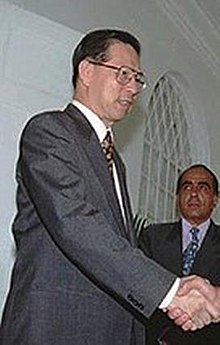Ong Teng Cheong | |
|---|---|
王鼎昌 | |
 Ong in 1997 | |
| 5th President of Singapore | |
| In office 1 September 1993 – 1 September 1999 | |
| Prime Minister | Goh Chok Tong |
| Preceded by | Wee Kim Wee |
| Succeeded by | S. R. Nathan |
| 3rd Deputy Prime Minister of Singapore | |
| In office 2 January 1985 – 16 August 1993 Serving with Goh Chok Tong (1985–1990) and Lee Hsien Loong (1990–2004) | |
| Prime Minister | Lee Kuan Yew Goh Chok Tong |
| Preceded by | Goh Keng Swee S. Rajaratnam |
| Succeeded by | Lee Hsien Loong Tony Tan |
| 2nd Chairman of the People's Action Party | |
| In office 5 January 1981 – 16 August 1993 | |
| Preceded by | Toh Chin Chye |
| Succeeded by | Tony Tan |
| Secretary-General of the National Trades Union Congress | |
| In office May 1983 – 1 September 1993 | |
| Deputy | Goh Chee Wee |
| Preceded by | Lim Chee Onn |
| Succeeded by | Lim Boon Heng |
| Minister for Labour | |
| In office 5 January 1981 – 9 May 1983 | |
| Prime Minister | Lee Kuan Yew |
| Preceded by | Ong Pang Boon |
| Succeeded by | E. W. Barker |
| Minister for Communications | |
| In office 1 July 1977 – 9 May 1983 | |
| Prime Minister | Lee Kuan Yew |
| Preceded by | Lim Kim San |
| Succeeded by | Ong Pang Boon |
| Member of the Singapore Parliament for Toa Payoh GRC (Kim Keat) | |
| In office 21 August 1991 – August 1993 | |
| Preceded by | Constituency established |
| Succeeded by | Constituency abolished |
| Member of the Singapore Parliament for Kim Keat SMC | |
| In office 2 September 1972 – 14 August 1991 | |
| Preceded by | Constituency established |
| Succeeded by | Constituency abolished |
| Personal details | |
| Born | Ong Teng Cheong 22 January 1936 Singapore, Straits Settlements |
| Died | 8 February 2002 (aged 66) Tanglin, Singapore |
| Cause of death | Lymphoma |
| Resting place | Mandai Crematorium and Columbarium |
| Political party | Independent |
| Other political affiliations | People's Action Party (1972–1993) |
| Spouse | |
| Children | 2 |
| Alma mater | University of Adelaide (BArch) University of Liverpool (MCD) |
| Occupation |
|
Ong Teng Cheong[a] GCMG (22 January 1936 – 8 February 2002) was a Singaporean politician, architect, and union leader who served as the fifth president of Singapore from 1993 to 1999. He was the first directly elected president in Singapore's history.[1] Born in the Straits Settlements, Ong was educated at the University of Adelaide and studied architecture. He later received a Colombo Plan scholarship and graduated from the University of Liverpool with a master's degree in urban planning.
Prior to his presidency, he was a member of the governing People's Action Party (PAP). Ong served as Chairman of the PAP between 1981 and 1993, after Toh Chin Chye stepped down from the position in 1981. He was the Member of Parliament (MP) for Kim Keat Single Member Constituency between 1972 and 1991 and the Kim Keat division of Toa Payoh Group Representation Constituency between 1991 and 1993, after the constituency was absorbed into the GRC. His ministerial positions included Minister for Communications between 1978 and 1981, Minister for Labour between 1981 and 1983, and Deputy Prime Minister between 1985 and 1993. During his tenure in Parliament, Ong was known for being the main advocate behind the construction of an extensive rail network in the country, known as the Mass Rapid Transit (MRT), the largest construction project in Singapore's history.
In 1993, Ong resigned from the PAP and his ministerial positions to contest in the 1993 presidential election, winning 58.7% of the vote. Ong was nicknamed the "People's President" and he was sworn in on 1 September 1993 as the fifth president of Singapore. He decided not to run for a second term as president in 1999, in part due to the death of his wife. He was succeeded by S. R. Nathan on 1 September 1999.[2] Ong died in his sleep from lymphoma at his Dalvey Estate residence in Tanglin on 8 February 2002, at the age of 66.
Cite error: There are <ref group=lower-alpha> tags or {{efn}} templates on this page, but the references will not show without a {{reflist|group=lower-alpha}} template or {{notelist}} template (see the help page).
- ^ "ONG TENG CHEONG". www.esplanade.com. Retrieved 26 October 2021.
- ^ Istana Singapore. "The President". Archived from the original on 11 June 2011.